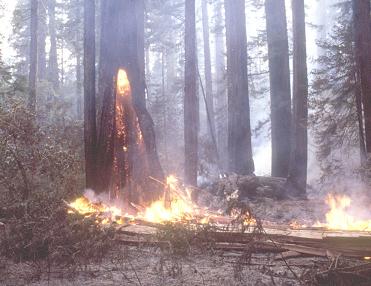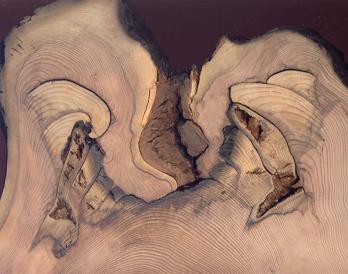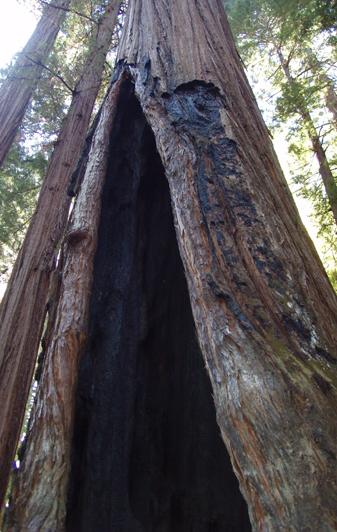|
Fire in Coast Redwood Forests
 The story of fire in coast redwood is unlike that of most other western forests. The moldy, foggy and humid environment of the redwood coast doesn't seem particularly fire prone. Lightning ignitions are relatively rare and most historical fires, whether frequent or not, are thought to have been started by people. Because of these human and climate factors, we have long struggled to understand fire in coast redwood. More... The story of fire in coast redwood is unlike that of most other western forests. The moldy, foggy and humid environment of the redwood coast doesn't seem particularly fire prone. Lightning ignitions are relatively rare and most historical fires, whether frequent or not, are thought to have been started by people. Because of these human and climate factors, we have long struggled to understand fire in coast redwood. More...
Is fire natural? Is fire a concern? Is fire useful? These three contentious questions surround coast redwood fire research and management at the beginning of the 21st century.
For centuries, the various Native American tribes of the area employed fire as a tool, and fire was widely employed by loggers to reduce debris to make their work easier. Until the great shift of public sentiment against fire occurred in the early 20th century, fire was an accepted part of coast redwood forest management. More...
If fire regimes have been mostly culturally driven here, are there ecological or social implications of fuel accumulation and climate change? After centuries with fire, are there forest attributes at stake that require fire for their persistence? In what part of the coast redwood range is wildfire likely, and how can we prevent undesirable outcomes with prescribed fire?
These applied questions reflect a great shift from the old view of fire as a threat with no redeeming value to fire as a tool that can help maintain the attributes that we value. The discussion has shifted from "is fire good or bad" to "what are the tradeoffs of active fire use, wildfire, and fire exclusion?"
Tradeoffs
Some tradeoffs associated with fire and fire use reflect the evolutionary response of coast redwood forests to fire. These "classical" fire effects include increased mortality of any forest species associated with (4) fuel type and fuel accumulation and (5) coast redwood's peculiar risk of mortality associated with cavity formation and development.
Other tradeoffs involve novel factors. In other words, they are relatively new to the system and/or they are new as management issues. Recent change means that the forest ecosystem is still in the process of adjusting to these new conditions-- a concept that has broad implications for how we assess risk and contextualize fire effects. Among the greatest of these novelties in coast redwood fire management are (1) changes in land use and landscape patch structure from past logging and development, (2) invasive species and (3) sensitive wildlife constraints often resulting from loss of habitat. Decisions to burn or to not burn weigh the short and long term consequences of fire and fire exclusion to values associated with these diverse issues.
Fire History
One pathway to better understand management tradeoffs is to solidly grasp how existing forests came to be the way they are today. Forest structure and composition are known to result in large part from past disturbances, like fire, flooding and winds.
Residual old-growth forests harbor abundant visible evidence of fire in the form of basal and canopy fire cavities and charred and fire-notched bark. Fires clearly burned almost everywhere over the coast redwood range sometime in the past, but were these fires just rare events, or are wildfires likely to become more common here as they have in the interior forests? Do fires burn due to fuel accumulation or in synchrony with climate variation, or were past fires just the result of cultural needs?
Answers to these questions have been slow in coming.
 Early observers suggested the existance of a strong north-south gradient of fire frequency within the redwood forest and beginning with the work of Emanuel Fritz in the 1920s, the antiquity of fire in coast redwood became clear. In the southern and central redwood forests, fire was thought to occur with a quarter-century frequency on average, while evidence from the north suggested that fire was infrequent, occurring episodically over many decades or centuries. Although thought to be rare in the north, fire was known to be important for the establishment of long-lived seeded trees like Douglas fir. Early observers suggested the existance of a strong north-south gradient of fire frequency within the redwood forest and beginning with the work of Emanuel Fritz in the 1920s, the antiquity of fire in coast redwood became clear. In the southern and central redwood forests, fire was thought to occur with a quarter-century frequency on average, while evidence from the north suggested that fire was infrequent, occurring episodically over many decades or centuries. Although thought to be rare in the north, fire was known to be important for the establishment of long-lived seeded trees like Douglas fir.
Coast redwood is a difficult tree to work with, as fire scars are readily lost to decay and those that do form often do so only below a height of 30 cm. Early efforts understandably used stump surfaces, but this sampling height was far too high to capture the actual fire history. Because of this methodological legacy, all early efforts, particularly those that reported fire intervals greater than 20 years, both in the south and in the north are suspect. More recent efforts indicate that fire appears to have been far more frequent and prevalent than early research suggested. More...
 Before the mid 20th century, dry sites in the north and south typically burned with less than a 20 year frequency prior to fire exclusion. A 10-15 year frequency appears to be common, and in several studies, fires occasionally burned the same site after only a few years. Fire was no less frequent across most of the coast redwood range than it was in other dry sites of California, and these fires likely had profound effects on vegetation structure and composition. Before the mid 20th century, dry sites in the north and south typically burned with less than a 20 year frequency prior to fire exclusion. A 10-15 year frequency appears to be common, and in several studies, fires occasionally burned the same site after only a few years. Fire was no less frequent across most of the coast redwood range than it was in other dry sites of California, and these fires likely had profound effects on vegetation structure and composition.
Remarkably, fire was also common in many of the humid portions of the northern redwood forest. Such a prevalent role for fire in the north reflects the presence of Native Americans who burned for resource benefit for centuries. In humid sites, it seems likely that the fire frequencies were conditioned on the decisions of a few individuals and the ability of their ignitions to spread more broadly--fire spread reflected fuel and climate conditions that varied over time at northern coastal sites.
Analysis of fire scars in tree rings has also revealed how fires generate the large fire cavities that are common across the coast redwood range. Known locally as "goosepens" because early Euro-American settlers used them as livestock pens, these cavities destabilize trees and can ultimately lead to their collapse. Fire causes surface scarring and decay and decayed wood readily burns if healing has not yet occurred. Longer periods without fire can lead to more fuel, and more fire, scarring and decay. This results in complex tradeoffs that redwood forest managers need to consider before burning or not burning. More...
In light of the above discussion, the value of understanding fire history is not that it tells us what is necessary for the preservation of the forest, but it tells us how characteristics of the forest came to be and it suggests how things might change with future fire use or disuse. Insights into how fires of the past occurred and how they affected values of concern provide managers with important answers; but these take the form of explicating the likely consequences of difficult tradeoffs.
Related Pages:
Steve Norman
|
|

